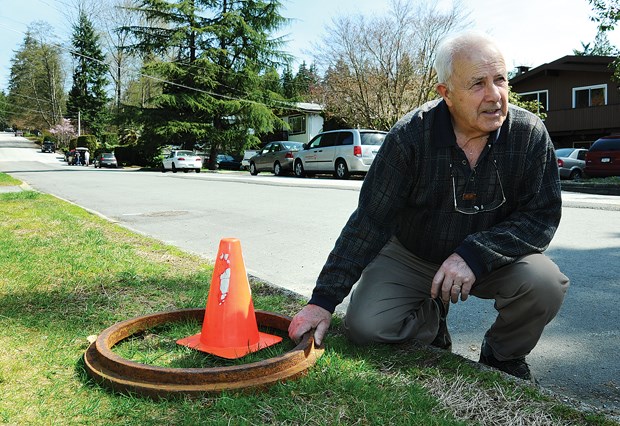A group of Lynn Valley residents say the District of North Vancouver botched the repair of a broken water main, and then stuck them with the bill, though the district says the main was shut off professionally and quickly.
The water main burst just before 1:30 p.m. on Sept. 23, 2012 on Pierard Road at the 1700-block of Westover Road, flooding several homes below and causing at least $100,000 in damage to 10 homes, according to resident Ted Winram, whose insurance covered $10,000 in repairs.
A district technician arrived and, after two attempts, shut down the correct valve isolating the break. Exactly when that happened and how long it took, though, is disputed.
Winram filed a number of freedom of information requests with the district and found a discrepancy with the district's timeline. While the technician's notes indicated the water was off by 2:24 p.m. the District of North Vancouver Fire and Rescue Service dispatcher's log states at 2:56 p.m.: "Water is off/residual flooding."
Neighbours report the water continued to flow as if under pressure until 3:30 p.m., with most of the damage being done in the last hour. Winram said his insurer has warned him if he suffers another flood, he won't be able to get insurance again because he lives in a "flood plain," despite being hillside in Lynn Valley.
Local governments aren't legally responsible for damages done to private property unless clear negligence was a factor. While Winram and his neighbours maintain the district's response was negligent, the Municipal Insurance Association disagreed. Not included in the notes Winram acquired through his FOI were phone records and other notes that indicate the valve was shut off sooner, according to Lorne Carter, district manager of utilities.
"We think it's probably around 20 minutes from the time he arrived to the time he isolated the water main break," said Carter. "As soon as he finished isolating the water main break, he called the province and alerted them of the water main break as we're mandated to do when we think a water main break will enter a waterway. We have the phone records."
Beyond that, Carter said the on-call staff member who responded to the break is dedicated and experienced.
"This particular operator prides himself on getting there as quickly as he can and dealing with the shut-off. He's a longtime employee. He recognizes the damage that water causes and how stressful it can be," he said.
As for the discrepancy between the notes and fire dispatch record, Carter said dispatch notes aren't meant to be an exactly chronology.
"For sure, it's not the time it was shut off because (DNVFRS ) had a posting on their own Twitter site at 2:38 p.m. that the water was shut down and a photo validating that," Carter said. "I believe that was just the status they were reporting and not saying the water was just shut off. They don't normally monitor our activity in that way."
How long water runs from a broken pipe after the valve is shut depends on topography of the land and what type of soil is on top, Carter said. The steep slope and loose soil on top of the pipe probably gave the impression the water was still flowing with the valve open, he added.
Responding to the district's version of events, Winram remains adamant the timeline doesn't gel with reality. "I know our times are all right on. I know all my neighbours know that too because they were all there for the whole thing," he said, adding he plans to continue pursuing the matter with the district.
Ultimately, Winram said district should pay for the damages, but he's more interested in seeing some accountability.
"They're the ones that actually caused this damage and if we can get that across, they will smarten up," Winram said. "We're just interested in getting the district to get a schedule that doesn't allow this long period of time for shutting the water down because it costs more and more the longer the water's on."
The district averages about 25 water-main breaks a year over its roughly 365 kilometres of underground lines. Most of the breaks are happening in the 70 kilometres of asbestos cement pipes installed in the 1950s. The district budgets $4 million a year for waterline replacement - a $70-million job.
Deciding which pipes get replaced is prioritized by a formula that factors in the risk of a break with the likely damage to property or the environment, as well as input from community members.



